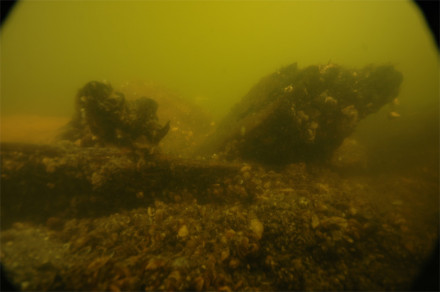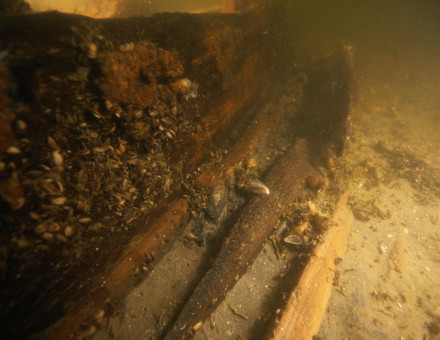History
Description
This site, containing an unknown wreck, was discovered around 2000 by amateur divers. The site, lying at only 3 to 4 meters depth, consists of the bottom part of a wreck, with a mound of possibly ballast stones on top of it. Schist stones, normally used as wetting stones (for sharpening tools) have been found. The wreck is fully clinker built. Down in the ship, not far from the keel, the frames are approximately 20 cm wide and 15 cm thick. They seem to be placed at regular distances from each other (also more or less 20 cm). The ceiling planks differ in width and thickness. The latter is probably because it concerns planks near the keelson. One of the thick planks is 40 cm wide and 23 cm thick. This is the inner keel or keelson. Their additional thickness may be for additional longitudinal strength. The outer planks also differ in width but not too much (somewhat above 30 cm). They have a regular thickness of 4 cm.

Description
The stones and wood are fully overgrown with zebra mussels. A first rough sketch of the site and the construction has been produced during a one hour survey.


Description
Wooden merchant ship, type resembles a Hulk. Clinker built.
Length: ca. 20 m (1:3). Site is 17x7 m; the remains are 11 m.
Vessels from the early 16th Century are fairly rare. The remains are of the aft of the ship.



Status
The wreck will stay in situ. A short survey was conducted on the site in 2009 together with divers from the amateur archeology organization LWAOW/Archeos Fryslân work group. In April 2012 the Cultural Heritage Agency of the Netherlands conducted a short archaeological survey to monitor and investigate and to train students of maritime archeology in the field.
References
- J. Opdebeeck, M. Manders, T. Coenen (2014).
Scheepswrak Stavoren 17.
RAM 221.
Rijksdienst voor het Cultureel Erfgoed. - RCE.
RAM 221: Scheepswrak Stavoren 17.